Related Research Articles

Marazion is a civil parish and town, on the shore of Mount's Bay in Cornwall, England, United Kingdom. It is 2 miles (3.2 km) east of Penzance and the tidal island of St Michael's Mount is half-a-mile offshore. At low water a causeway links it to the town and at high water passenger boats carry visitors between Marazion and St Michael's Mount. Marazion is a tourist resort with an active community of artists who produce and sell paintings and pottery in the town's art galleries.

Newlyn is a seaside town and fishing port in south-west Cornwall, England, United Kingdom. It is the largest fishing port in England.

The Diocese of Truro is a Church of England diocese in the Province of Canterbury which covers Cornwall, the Isles of Scilly and a small part of Devon. The bishop's seat is at Truro Cathedral.


St Hilary is a civil parish and village in west Cornwall, England, United Kingdom. It is situated approximately five miles (8 km) east of Penzance and four miles (6.5 km) south of Hayle.

Mullion is a civil parish and village on the Lizard Peninsula in south Cornwall, England, United Kingdom. The nearest town is Helston approximately 5 miles (8 km) to the north.
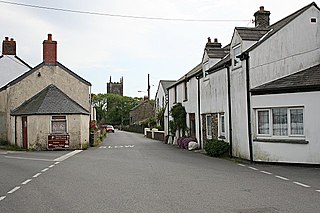
St Newlyn East is a civil parish and village in Cornwall, England, United Kingdom. The village is approximately three miles (5 km) south of Newquay. The name St Newlyn East is locally abbreviated to Newlyn East and according to an anonymous historian writing in The Cornishman in 1880 it was only in recent years that Saint had been added to the parish name.

St Allen is a civil parish in Cornwall, England, United Kingdom. The church town of St Allen is an isolated hamlet and the main settlement in the parish is Zelah which is situated on the A30 trunk road four miles (6.5 km) north of Truro.

Cubert is a village in Cornwall, England, United Kingdom. It is three miles (5 km) south-southwest of Newquay and is in the civil parish of Cubert.
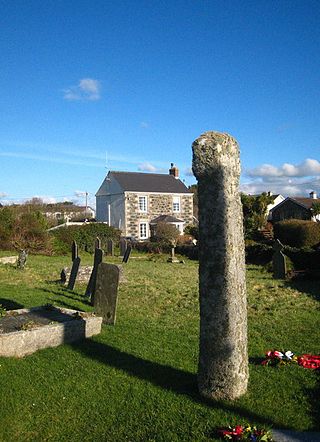
Cury is a civil parish and village in southwest Cornwall, England, United Kingdom. It is situated approximately four miles (6 km) south of Helston on The Lizard peninsula. The parish is named for St Corentin and is recorded in the Domesday Book as Chori.
Cornish dance originates from Cornwall, UK. It has largely been shaped by the Cornish people and the industries they worked in. In most cases, particularly with the step dancing, the dances were still being performed across the region when they were collected.
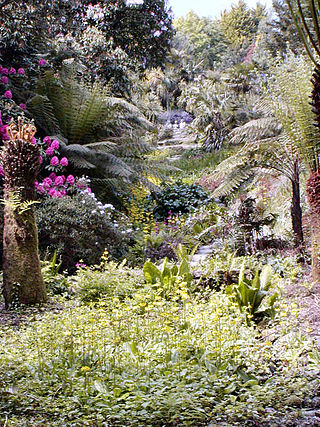
Cornwall is the county that forms the tip of the southwestern peninsula of England; this area has a mild and warm climate regulated by the Gulf Stream. The mild climate allows rich plant cover, such as palm trees in the far south and west of the county and in the Isles of Scilly, due to sub-tropical conditions in the summer.

Warleggan or Warleggon is a civil parish on the southern edge of Bodmin Moor in Cornwall, England, United Kingdom.

The Church of St Hilary is an Early English–style church in the village of St Hilary, Cornwall, England. It features a 13th-century tower. Following a fire in 1853, the remainder of the church was rebuilt two years later by William White. The church is dedicated to Saint Hilary of Poitiers and is a Grade I listed building. The architecture is described in Pevsner's Buildings of England: Cornwall.
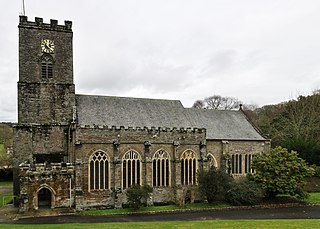
Christianity in Cornwall began in the 4th or 5th century AD when Western Christianity was introduced as in the rest of Roman Britain. Over time it became the official religion, superseding previous Celtic and Roman practices. Early Christianity in Cornwall was spread largely by the saints, including Saint Piran, the patron of the county. Cornwall, like other parts of Britain, is sometimes associated with the distinct collection of practices known as Celtic Christianity but was always in communion with the wider Catholic Church. The Cornish saints are commemorated in legends, churches and placenames.

Fishing in Cornwall, England, UK, has traditionally been one of the main elements of the economy of the county. Pilchard fishing and processing was a thriving industry in Cornwall from around 1750 to around 1880, after which it went into an almost terminal decline. During the 20th century the varieties of fish taken became much more diverse and crustaceans such as crab and lobster are now significant. Much of the catch is exported to France due to the higher prices obtainable there. Though fishing has been significantly damaged by overfishing, the Southwest Handline Fishermen's Association has started to revive the fishing industry. As of 2007, stocks were improving. The Cornwall Sea Fisheries Committee is one of 12 committees responsible for managing the corresponding Sea Fisheries District. The Isles of Scilly Sea Fisheries Committee is responsible for the Scilly district.
The Cornish dialect is a dialect of English spoken in Cornwall by Cornish people. Dialectal English spoken in Cornwall is to some extent influenced by Cornish grammar, and often includes words derived from the Cornish language. The Cornish language is a Celtic language of the Brythonic branch, as are the Welsh and Breton languages. In addition to the distinctive words and grammar, there are a variety of accents found within Cornwall from the north coast to that of the south coast and from east to west Cornwall. Typically, the accent is more divergent from Standard British English the further west through Cornwall one travels. The speech of the various parishes being to some extent different from the others was described by John T. Tregellas and Thomas Quiller Couch towards the end of the 19th century. Tregellas wrote of the differences as he understood them and Couch suggested the parliamentary constituency boundary between the East and West constituencies, from Crantock to Veryan, as roughly the border between eastern and western dialects. To this day, the towns of Bodmin and Lostwithiel as well as Bodmin Moor are considered the boundary.

Harold Harvey (1874–1941) was a Newlyn School painter who painted scenes of working class Cornish fishermen, farmers and miners and Cornish landscapes. He was born in Penzance and trained at the Penzance School of Arts under Norman Garstin and the Académie Julian in Paris (1894–1896).
Annie Walke or Anne Fearon Walke was an English artist. Anne Fearon grew up and was schooled in Banstead, Surrey. After completing her studies at the Chelsea School of Art and the London School of Art, she and her sister, Hilda Fearon, furthered their studies in Dresden, Germany. About the turn of the 20th century Miss Fearon settled in Cornwall, where she continued her studies and established a studio in the Cornish coastal village of Polruan. After she married Nicolo Bernard Walke in 1911, she soon moved with him to St Hilary, Cornwall. where her husband became the vicar in 1913. She was a member of the Newlyn School and other artists' organizations and created portraits and religious works for churches. Her work has been exhibited in England, Paris, America and South Africa. In the latter part of her life Walke was a published poet.
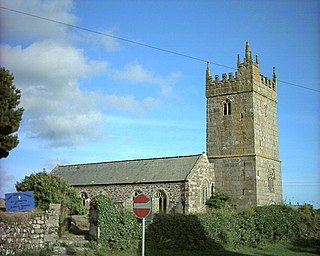
St Corentine's Church, Cury is a Grade I listed parish church in the Church of England in Cury, Cornwall, England, UK.
References
- ↑ Photograph of 'Father Nicolo Bernard Walke b. 15 June 1874 at the Vicarage, Redlynch, Wiltshire. National Archive. Retrieved 2 October 2012.
- ↑ The Times, Thursday, 3 July 1941; pg. 1; Issue 48968; col B: Nicolo Bernard Walke at Battery Terrace, Mevagissey, on 25 June 1941
- ↑ Walke, Bernard (2002) Twenty Years at St Hilary. Mount Hawke: Truran; pp. 34, 116, 120 & 190
- 1 2 Walke, Bernard (2002) Twenty Years at St Hilary. Mount Hawke: Truran, pp. 5–6, 12.
- ↑ Walke, Bernard (2002) Twenty Years at St Hilary. Mount Hawke: Truran, p. 152.
- 1 2 3 4 Annie Walke. Cornwall Artists. Retrieved 1 October 2012.
- ↑ Rendell, Joan (1982) Cornish Churches. St Teath: Bossiney Books; p. 64
- ↑ Walke, Bernard (2002) Twenty Years at St Hilary. Mount Hawke: Truran, pp. 238–39.
- 1 2 3 Claughton Pellew; Anne Stevens; Ashmolean Museum. Claughton Pellew: wood engravings : Ashmolean Museum, Eldon Gallery, 16 September-22 November 1987 . Ashmolean Museum; September 1987. p. 14.
- ↑ Walke, Bernard (2002) Twenty Years at St Hilary. Mount Hawke: Truran; p. 168
- 1 2 Anne Walke. Penlee House Museum and Gallery. Retrieved 1 October 2012.
- ↑ "Walke resigned in 1936, his faith in the Church of England shattered."--H. M. Brown. A Century for Cornwall. Truro: Oscar Blackford, 1976. p. 99.
- 1 2 Rendell, Joan (1982) Cornish Churches. St Teath: Bossiney Books; pp. 64, 66, 68.
- ↑ H. M. Brown. A Century for Cornwall. Truro: Oscar Blackford, 1976. p. 95.
- ↑ Walke, Bernard (2002) Twenty Years at St Hilary. Mount Hawke: Truran; pp. 39, 198–99.
- 1 2 "Reverend Bernard Walke and His Mother." BBC. Your Paintings. Retrieved 2 October 2012.
- ↑ George Bednar. Every Corner was a Picture: 120 Artists of Newlyn and the Newlyn Art Colony 1880–1990 . Truran Books; November 2004. ISBN 978-1-85022-192-0.
- ↑ Melissa Hardie. 100 Years in Newlyn: Diary of a Gallery . Hypatia Publications; 1 June 1995. ISBN 978-1-872229-22-5. p. 1915. Note: previous page to where this link lands, ironically not a page 1914.
- ↑ H. M. Brown. A Century for Cornwall. Truro: Oscar Blackford, 1976. p. 98.
- ↑ Brown, H. Miles (1976). A Century for Cornwall. Truro: Blackford. pp. 98–100.
- ↑ Walke, Bernard (2002) Twenty Years at St Hilary. Mount Hawke: Truran; pp. 237–42
- ↑ Walke, Bernard (2002) Twenty Years at St Hilary. Mount Hawke: Truran; pp. 168–76
- 1 2 St Hilary's Home, Walsingham. Archived 28 June 2013 at the Wayback Machine St Hilary's. Retrieved 4 October 2012.
- ↑ Walke, Bernard (2002) Twenty Years at St Hilary. Mount Hawke: Truran; p. 190
- ↑ Village Celebrates New Community Heritage Centres. This is Cornwall. Retrieved 4 October 2012.
- ↑ "Our Lady's Mirror Autumn Number 1957." St Hilary's, Walsingham. Retrieved 4 October 2012.
- ↑ "Obituary of Fr Alban Henry Baverstock (died 25 April 1950), Our Lady's Mirror, Summer 1950." St Hilary's, Walsingham. Retrieved 4 October 2012.
- ↑ Walke, Bernard (2002) Twenty Years at St Hilary. Mount Hawke: Truran; pp. 190–97
- ↑ Walke, Bernard (2002) Twenty Years at St Hilary. Mount Hawke: Truran; pp. 199, 202.
- ↑ Walke, Bernard (2002) Twenty Years at St Hilary. Mount Hawke: Truran; pp. 244–46
- ↑ Walke, Bernard (2002) Twenty Years at St Hilary. Mount Hawke: Truran
- ↑ Allchin, A. M. (2002) "Introduction" to: Walke, Bernard (2002) Twenty Years at St Hilary. Mount Hawke: Truran; pp. 5–7
- ↑ Walke, Bernard (2002) Twenty Years at St Hilary. Mount Hawke: Truran; pp. 32–35
- ↑ Twenty Years at St. Hilary. Open Library. Retrieved 3 October 2012.
- ↑ Plays from St. Hilary. Open Library. Retrieved 3 October 2012.